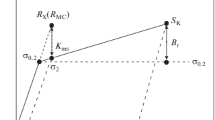Abstract
With a view to ensuring structural stability of steels and alloys, a system for harmonizing the plasticity, strength, and deformation resistance of structural steels is developed. Principles for the formation of such properties are outlined. Means of controlling the change in these properties are considered. The sensitivity of some characteristics of the metal to changes in others is discussed. The reserves of strength in various structural steels are compared in terms of their ability to resist brittle failure, on the basis of the mechanical stability Kms and the embrittlement expressed as the deformational strength (fracture resistance) Br. The quality of structural steels is assessed in terms of their ability to resist embrittlement. The proposed approach here is to assess the quality of structural steels in terms of their deformational strength at specified yield point σ0.2, which reflects the resistance to embrittlement.
Similar content being viewed by others
References
Shiyan, A.V., Kotrechko, S.A., Meshkov, Yu.Ya., et al., Interaction of strength, plasticity, and mechanical stability of construction steels, Metalozn. Term. Obrob. Met., 2013, no. 4, pp. 12–30.
Meshkov, Yu.Ya., Kotrechko, S.A., and Shiyan, A.V., Mekhanicheskaya stabil’nost’ metallov i splavov (Mechanical Strength of Metals and Alloys), Kyiv: Naukova Dumka, 2014.
Shiyan, A.V. and Meshkov, Yu.Ya., Okhrupchivanie metallicheskikh splavov v usloviyakh kontsentratsii napryazhenii. Konstruktsionnye stali i titanovye splavy (Embrittlement of Metal Alloys Under Stress Concentration. Construction Steels and Titanium Alloys), Saarbrucken: LAP LAMBERT Academic, 2015.
Kotrechko, S.A. and Meshkov, Yu.Ya., Predel’naua prochnost’. Kristally, metally, konstruktsii (Maximum Strength: Crystals, Metals, and Constructions), Kyiv: Naukova Dumka, 2008.
Hollomon, J.H., Tensile deformation, Trans. Metall. Soc. AIME, 1945, vol. 162, pp. 268–290.
Meshkov, Yu.Ya. and Shiyan, A.V., Evaluation of mechanical quality of construction steels by their resistance to brittle fracture under uniaxial tension, Mekh. Mash., Mekh. Mater., 2014, no. 4 (29), pp. 75–81.
Meshkov, Yu.Ya. and Shiyan, A.V., Relationship of material strength with durability of construction elements, Mekh. Mash., Mekh. Mater., 2017, no. 1 (38), pp. 79–86.
GOST (State Standard) 1497-84: Metals. Methods of Tension Test, Moscow: Izd. Standartov, 1984.
Smida, T., Babjak, J., and Dlouhy, I., Prediction of fracture toughness temperature dependence from tensile test parameters, Kovove Mater., 2010, vol. 48, pp. 1–8.
Author information
Authors and Affiliations
Corresponding author
Additional information
Original Russian Text © A.V. Shiyan, Yu.Ya. Meshkov, G.P. Zimina, 2018, published in Stal’, 2018, No. 6, pp. 47–54.
About this article
Cite this article
Shiyan, A.V., Meshkov, Y.Y. & Zimina, G.P. Optimal Mechanical Properties of Structural Steel for the Prevention of Embrittlement. Steel Transl. 48, 393–402 (2018). https://doi.org/10.3103/S0967091218060086
Received:
Published:
Issue Date:
DOI: https://doi.org/10.3103/S0967091218060086




